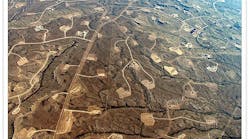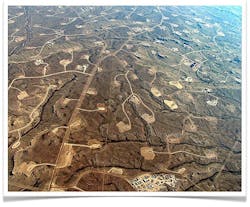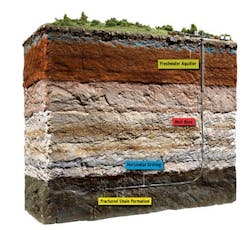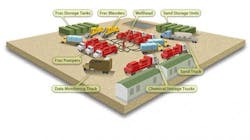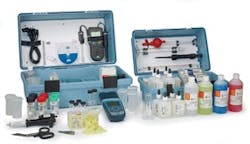In the process of fracking, high-pressure water mixed with chemicals and sand is injected into layers of shale rocks deep under ground, which fracture under this pressure and release the gas and oil they contain. In 2005, Congress passed legislation prohibiting the federal government from regulating this industry and allowing it to not disclose what chemicals are being injected into the ground. This unregulated operation continued for a decade because of the argument that these processes were "proprietary," as they require unique machinery capable of driving the fluid down more than a mile, and also require a lot of science to calculate the exact mixtures of water, chemicals and sand required to crack the tiny fissures in the rock.
After many years, federal regulations are now being introduced, at least for the 100,000 fracking and regular oil and gas wells that are located on public lands. As of now, the states will still maintain jurisdiction over the wells drilled on private land. We do not accurately know their total number, but we do know that about one million unregulated wells have already been abandoned, and of those some 200,000 have never even been plugged.
See also: Controls for drilling oil and gas wells
One of the reasons why such large numbers are abandoned is the high depletion rate of their production. The "staying power" of these wells is short. In just the first year of operation, the production can drop 50% (see this report from Bloomberg Business). Therefore, in order to maintain or increase the total national production, the drilling of new wells is needed continuously.
Federal regulations that are just coming into effect cover several areas of fracking operation where protection of public safety is involved. Here and in future articles, I discuss these areas one at a time and also describe how process control and automation can and should be used to reach these goals. I particularly focus on the potential of automation for monitoring the types of toxic chemicals and their escape or leaking into ground and surface waters.
Are fracking fluids toxic?
Fracking fluids contain "proppants," such as sand, water and a large number of chemicals, that serve to keep the fractures in the shale open. In the past, the identity of these chemicals was not disclosed by their suppliers like Halliburton who considered that information proprietary (Figure 1).
Fracking in Wyoming – four oil pads are located on every square kilometer. Courtesy of The Equation
After the drilling is completed fracking starts using a number of large number of above ground equipment serving storage, blending and high pressure pumping.
Figure 1: An average well, over its lifetime, uses some 5 million gallons (19,000 m3) of water for both fracking and re-fracking. This water contains sand and toxic chemicals and is injected under a pressure of up to some 20,000 PSIG (~ 130 bars) at depths of up to 20,000 feet (~ 6 kilometers).
Samples from well blowouts and fluid pits in Colorado, Wyoming and New Mexico have shown that the fracking fluids contain more than 100 different kinds of chemicals, some of them having adverse side effects including brain damage, birth defects and cancer. In other locations, heavy metals, salts (bromides, chlorides), acetone, radionuclide isotopes (strontium, barium), arsenic and volatile substances (methane, benzene, alcohol, toluene, phenol, ethylene glycol) were found in the fracking fluids.
Benzene causes cancer and bone marrow failure; lead damages the nervous system and causes brain disorders; ethylene glycol (antifreeze) can cause death; methanol is highly toxic; boric acid causes kidney damage; 2-butoxyethanol causes hemolysis (destruction of blood cells). Whatever chemicals the fracking fluids contain, they can end up in the ground water and the drinking water supplies through ground penetration or due to leaks in the piping or in the lining of the "frack ponds."
We have all heard arguments that "we put a lot worse stuff in our food, our yard and garden" than the fracking chemicals. This is true. Yet, we should still be more careful in protecting our drinking water supplies. The new federal regulations will require disclosure of the identity of the fracking chemicals and the methods used to prevent their release during fracking, storage in lined surface pits or disposal in ways such as injection into dry deep wells, which can and did cause minor earthquakes. Some consider this reinjection desirable to rebalance the underground pressures, because without that, ground movement (minor earthquakes) might result; others argue that it is this practice itself that can cause earthquakes.
Process control can increase safety
The potentials of process control are not yet exploited in the area of water composition monitoring. We do not yet have inexpensive, portable, multivariable, wireless and smart water composition detectors that would allow quick measurement and wireless transmission of monitoring data. We do have manual analysis kits (Figure 2) and portable, smart and multivariable detectors (Figure 3), and we do have wireless transmitters (See Wireless Control Foundation: Continuous and Discrete Control and Process Industry by T. Blevins, D. Chen, M. Nixon and W. Wojszinis, published by ISA), but we do not have devices that would combine all these features.
The equipment used during fracking include a number of chemical trucks. Courtesy of FracFocus.
Courtesy ProPublica
Figure 2: Fracking fluids contain about 90% water, nearly 10% sand and less then 0.5% of other chemicals, serving the functions that are listed above. Since the total quantity of these fluids is millions of gallons, this 0.5% can represent a substantial quantity of chemicals.
Figure 3: Hydraulic fracturing water analysys kit. Courtesy of Hach Co.
Today the common practice is to provide a small water analysis laboratory in a data monitoring truck at the fracking site. These analysis kits provide the means for the manual analysis of the composition of source water, fracturing fluid, flow-back water, drilling fluids, etc. They can measure alkalinity, bacteria (iron-related, sulfate-reducing, and slime-forming), barium, boron, chloride, conductivity, hardness (total as CaCO3), iron (total as Fe), pH, sulfate, sulfide, silica, chlorine, manganese, etc. but require not only manual samples, but also well-trained technicians and much time to make each analysis.In the area of inexpensive, multivariable and automatic monitors/alarms, much development is needed, although some progress has been made. For example a spectrophotometer is available (Figure 4) which is capable of memorizing up to 25 calibrations and over 40 pre-programmed tests. These battery-operated units provide automatic wavelength selection and can be carried in small suitcases, but still require the use of manual samples in sample tubes.
Figure 4: Smart Spectrophotometer. Courtesy of LeMotte Co.
In future articles I will discuss the process control means of drastically reducing methane leakage to the atmosphere and to thereby save a valuable fuel (worth billions) and to lower the discharge of a powerful greenhouse gas that is some 30 times more potent than carbon dioxide.
